Jeep Avenger vs VW T-Roc – Which one offers the better deal?
Everyday use, family trips or long-distance drives – here’s where the differences show.
Discover whether Jeep Avenger or VW T-Roc fits your lifestyle better.
An Overview of the Compact SUV Segment
The compact SUV segment has been continuously growing, and two noteworthy contenders for potential buyers are the Jeep Avenger and the VW T-Roc. Both vehicles promise style, versatility, and the performance expected from their respective brands. In this comparison, we will delve into their technical specifications, innovations, and what they bring to the table.
Powertrain and Performance
The Jeep Avenger offers a range of powertrains, including electric and petrol options. It provides three engine variants, with the electric version boasting 156 horsepower, paired with a 51 kWh battery that offers up to 400 km of range. The Avenger performs impressively, accelerating from 0 to 100 km/h in just 9 seconds.
In comparison, the VW T-Roc provides a broader spectrum of choices, ranging from efficient petrol and diesel engines. Its engine lineup includes options delivering between 115 to 300 horsepower, ensuring a performance-oriented option for a variety of driving styles. The T-Roc’s performance is highlighted by its top-of-the-line variant, which can achieve 0-100 km/h in just 4.9 seconds.
Fuel Efficiency and Consumption
When considering fuel efficiency, the Jeep Avenger leads in the electric segment with a consumption rate of 15.4 kWh/100 km, making it a great option for eco-conscious buyers. Its petrol variant, however, offers a reasonable consumption of 5.7 L/100 km.
The T-Roc showcases impressive fuel consumption figures as well, with its most efficient diesel engine consuming as low as 4.7 L/100 km. The petrol options range from 5.6 to 7.3 L/100 km, which is competitive within the segment.
Interior Space and Comfort
Both the Jeep Avenger and VW T-Roc are designed with passenger comfort in mind. The Avenger offers a spacious interior, accommodating up to 5 passengers with a trunk capacity of 355 liters. However, the T-Roc shines with its trunk capacity ranging from 392 to 445 liters, providing additional utility for luggage and gear.
The T-Roc also provides a range of upscale options for interior materials and technology, creating an inviting atmosphere for both driver and passengers. The Avenger’s interior focuses on practicality and rugged design, which is characteristic of the Jeep brand.
Safety and Technology Innovations
Safety is paramount in both models. The Jeep Avenger is equipped with multiple advanced driver-assistance systems, including lane departure warning, adaptive cruise control, and automated emergency braking, which enhance overall safety and driving convenience.
The T-Roc stands out with its advanced infotainment system integrated with modern connectivity features. Its digital cockpit provides real-time driving data and media control, elevating the driving experience further.
Driving Dynamics
In terms of driving dynamics, the Jeep Avenger, being a front-wheel-drive SUV, is crafted for a smooth and comfortable ride, ideal for urban driving and light off-road adventures. Its compact dimensions also contribute to its agility in navigating through city streets.
The VW T-Roc, available in both front and all-wheel drive, offers a sportier driving experience with an emphasis on handling and stability. Its precise steering and suspension setup allow for confident cornering and highway cruising.
Final Thoughts
Choosing between the Jeep Avenger and VW T-Roc ultimately comes down to personal preference and intended use. If eco-friendliness and electric performance are priorities, the Avenger is an excellent choice. Conversely, if performance versatility, trunk space, and advanced technology are more critical, the T-Roc emerges as a stronger contender.
Both vehicles are impressive in their own right, offering unique advantages that cater to different segments of the market. Whether you seek an electric adventure or a sporty everyday SUV, either model promises a compelling driving experience.
Here’s where it gets real: The technical differences in detail
Costs and Efficiency:
Looking at overall running costs, both models reveal some interesting differences in everyday economy.
Jeep Avenger has a clearly perceptible advantage in terms of price – it starts at 21900 £, while the VW T-Roc costs 26400 £. That’s a price difference of around 4496 £.
Fuel consumption also shows a difference: Jeep Avenger manages with 4.90 L and is therefore somewhat more efficient than the VW T-Roc with 5.50 L. The difference is about 0.60 L per 100 km.
Engine and Performance:
Under the bonnet, it becomes clear which model is tuned for sportiness and which one takes the lead when you hit the accelerator.
When it comes to engine power, the Jeep Avenger has a minimal edge – offering 156 HP compared to 150 HP. That’s roughly 6 HP more horsepower.
In acceleration from 0 to 100 km/h, the VW T-Roc is hardly perceptible quicker – completing the sprint in 8.90 s, while the Jeep Avenger takes 9 s. That’s about 0.10 s faster.
In terms of top speed, the VW T-Roc performs barely noticeable better – reaching 212 km/h, while the Jeep Avenger tops out at 194 km/h. The difference is around 18 km/h.
There’s also a difference in torque: Jeep Avenger pulls minimal stronger with 260 Nm compared to 250 Nm. That’s about 10 Nm difference.
Space and Everyday Use:
Cabin size, boot volume and payload all play a role in everyday practicality. Here, comfort and flexibility make the difference.
Both vehicles offer seating for 5 people.
In curb weight, Jeep Avenger is distinct lighter – 1180 kg compared to 1465 kg. The difference is around 285 kg.
In terms of boot space, the VW T-Roc offers a bit more room – 475 L compared to 380 L. That’s a difference of about 95 L.
In maximum load capacity, the VW T-Roc performs minimal better – up to 1350 L, which is about 73 L more than the Jeep Avenger.
When it comes to payload, VW T-Roc minimal takes the win – 515 kg compared to 502 kg. That’s a difference of about 13 kg.
Who wins the race?
The VW T-Roc proves to be has the upper hand and therefore becomes our DriveDuel Champion!
VW T-Roc is the better all-rounder in this comparison.
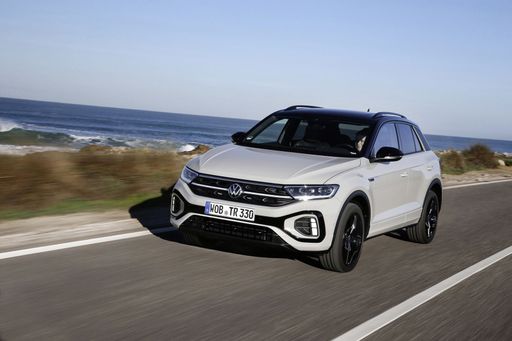 @ Volkswagen AG / VW Media
@ Volkswagen AG / VW Media
VW T-Roc
Jeep Avenger
The Jeep Avenger shrinks Jeep's boxy, adventurous styling into a city-friendly electric crossover that looks just as at home on tight streets as it does on muddy weekend lanes. It's a savvy pick for drivers who want go-anywhere attitude without the truck-size ego — practical inside, lively around town and ready to tackle a bit of rough stuff when the mood strikes.
details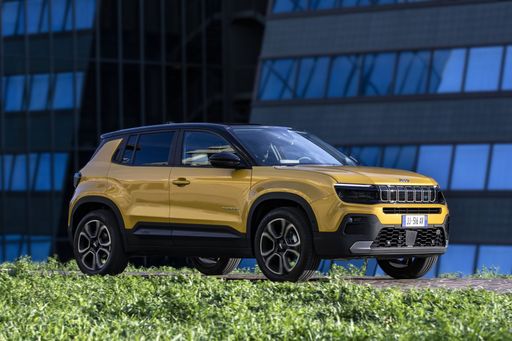 @ Jeep / Stellantis Media
@ Jeep / Stellantis Media
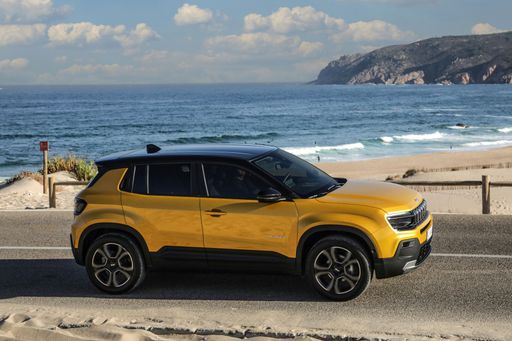 @ Jeep / Stellantis Media
@ Jeep / Stellantis Media
 @ Jeep / Stellantis Media
@ Jeep / Stellantis Media
 @ Jeep / Stellantis Media
@ Jeep / Stellantis Media
 @ Jeep / Stellantis Media
@ Jeep / Stellantis Media
VW T-Roc
The VW T-Roc mixes cheeky, coupe-like styling with the everyday sense and space of an SUV, so it looks fun without sacrificing family sense. It’s a likeable all-rounder with tidy road manners and plenty of personality, ideal if you want a car that’s practical enough for chores but entertaining enough to enjoy.
details @ Volkswagen AG / VW Media
@ Volkswagen AG / VW Media
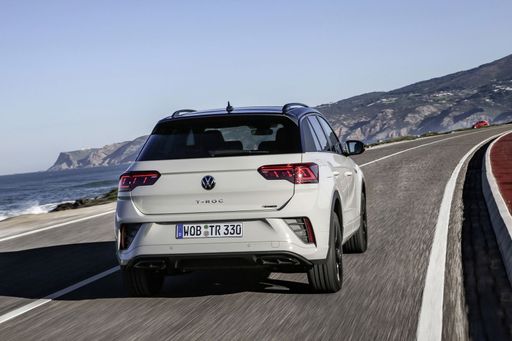 @ Volkswagen AG / VW Media
@ Volkswagen AG / VW Media
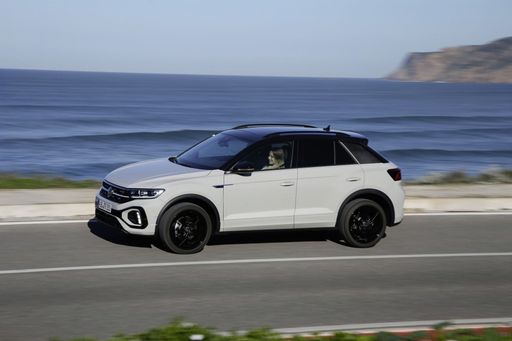 @ Volkswagen AG / VW Media
@ Volkswagen AG / VW Media
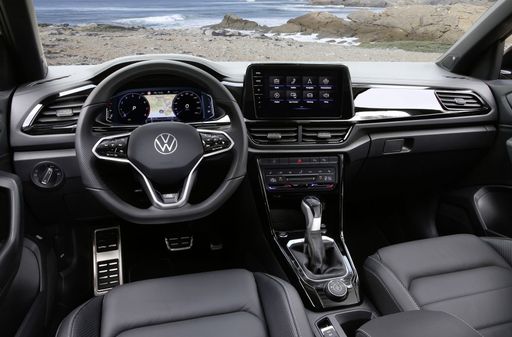 @ Volkswagen AG / VW Media
@ Volkswagen AG / VW Media
 @ Jeep / Stellantis Media
@ Jeep / Stellantis Media
|
 @ Volkswagen AG / VW Media
@ Volkswagen AG / VW Media
|
|
|
|
Costs and Consumption |
|
|---|---|
|
Price
21900 - 36900 £
|
Price
26400 - 38000 £
|
|
Consumption L/100km
4.9 - 5.7 L
|
Consumption L/100km
5.5 - 6.3 L
|
|
Consumption kWh/100km
15.50 kWh
|
Consumption kWh/100km
-
|
|
Electric Range
400 km
|
Electric Range
-
|
|
Battery Capacity
51 kWh
|
Battery Capacity
-
|
|
co2
0 - 129 g/km
|
co2
126 - 143 g/km
|
|
Fuel tank capacity
44 L
|
Fuel tank capacity
50 L
|
Dimensions and Body |
|
|---|---|
|
Body Type
SUV
|
Body Type
SUV
|
|
Seats
5
|
Seats
4 - 5
|
|
Doors
5
|
Doors
2 - 5
|
|
Curb weight
1180 - 1520 kg
|
Curb weight
1465 - 1539 kg
|
|
Trunk capacity
325 - 380 L
|
Trunk capacity
284 - 475 L
|
|
Length
4084 - 4088 mm
|
Length
4271 - 4373 mm
|
|
Width
1776 mm
|
Width
1811 - 1828 mm
|
|
Height
1527 - 1541 mm
|
Height
1527 - 1573 mm
|
|
Max trunk capacity
1218 - 1277 L
|
Max trunk capacity
1350 L
|
|
Payload
494 - 502 kg
|
Payload
368 - 515 kg
|
Engine and Performance |
|
|---|---|
|
Engine Type
Electric, Petrol, Petrol MHEV
|
Engine Type
Petrol, Petrol MHEV
|
|
Transmission
Automatic, Manuel
|
Transmission
Manuel, Automatic
|
|
Transmission Detail
Reduction Gearbox, Manual Gearbox, Dual-Clutch Automatic
|
Transmission Detail
Manual Gearbox, Dual-Clutch Automatic
|
|
Drive Type
Front-Wheel Drive, All-Wheel Drive
|
Drive Type
Front-Wheel Drive
|
|
Power HP
100 - 156 HP
|
Power HP
115 - 150 HP
|
|
Acceleration 0-100km/h
9 - 10.6 s
|
Acceleration 0-100km/h
8.9 - 12.3 s
|
|
Max Speed
150 - 194 km/h
|
Max Speed
187 - 212 km/h
|
|
Torque
205 - 260 Nm
|
Torque
200 - 250 Nm
|
|
Number of Cylinders
3
|
Number of Cylinders
3 - 4
|
|
Power kW
74 - 115 kW
|
Power kW
85 - 110 kW
|
|
Engine capacity
1199 cm3
|
Engine capacity
999 - 1498 cm3
|
General |
|
|---|---|
|
Model Year
2023 - 2025
|
Model Year
2024 - 2025
|
|
CO2 Efficiency Class
A, D, C
|
CO2 Efficiency Class
E, D
|
|
Brand
Jeep
|
Brand
VW
|
What drivetrain options does the Jeep Avenger have?
Available configurations include Front-Wheel Drive or All-Wheel Drive.
The prices and data displayed are estimates based on German list prices and may vary by country. This information is not legally binding.
